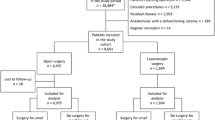Abstract
Background
Small bowel obstruction (SBO) after colectomy leads to markedly lower patient quality of life, longer hospital stays, and increased hospitalization costs. From a systemic treatment point of view, early postoperative SBO is one of the major concerns of the surgery because it often delays chemotherapy in advanced cases. The goal of this single-center study was to evaluate the risk factors for early postoperative SBO.
Methods
Univariate and multivariate analyses were performed for 1,004 patients who underwent open colectomy (OC, 421 patients) or laparoscopic-assisted colectomy (LAC, 583 patients) for colorectal cancer between January 1997 and December 2008.
Results
The overall early postoperative SBO were 45 cases (4.5%). Univariate analysis of the risk factors for early postoperative SBO showed no statistical significance between respective risk factors and occurrence of SBO for age >70 years, body mass index >25 kg/m2, ASA score ≥3, pT stage T4, pN stage ≥N1, pM stage M1, or increased blood loss. Multivariate analysis demonstrated that OC (odds ratio (OR), 2.62; 95% confidence interval (CI), 1.34–5.13; P = 0.005), and rectal cancer (OR, 2.12; 95% CI, 1.1–4.1; P = 0.025) were independent risk factors for postoperative SBO after colectomy for colorectal cancer. Regarding the causes of SBO, paralytic obstruction was more frequent in the LAC group, and adhesive obstruction was more frequent in the OC group.
Conclusions
Early postoperative SBO cases are more likely to occur with OC and rectal cancer. LAC is an effective surgical procedure from the perspective of reducing the incidence of early postoperative SBO after colectomy for colorectal cancer.
Similar content being viewed by others
References
Pickleman J, Lee RM (1989) The management of patients with suspected early postoperative small-bowel obstruction. Ann Surg 210:216–219
Ellis H, Moran BJ, Thompson JN et al (1999) Adhesion-related hospital readmissions after abdominal and pelvic surgery. Lancet 353:1476–1480
Braga M, Vignali A, Gianotti L et al (2002) Laparoscopic versus open colorectal surgery. A randomized trial on short-term outcome. Ann Surg 236:759–767
Weeks JC, Nelson H, Gelber S et al (2002) Short-term quality-of life outcomes following laparoscopic-assisted colectomy vs. open colectomy for colon cancer: a randomized trial. JAMA 287:321–328
Lacy AM, Garcia-Valdecasas JC, Delgado S et al (2002) Laparoscopy-assisted colectomy versus open colectomy for treatment of non-metastatic colon cancer: a randomized trial. Lancet 359:2224–2229
Schwenk W, Bohm B, Haase O et al (1998) Laparoscopic versus conventional colorectal resection: a prospective randomized study of postoperative ileus and early postoperative feeding. Langenbecks Arch Surg 383:49–55
Vrijland WW, Jeekel J, van Geldorp HJ et al (2003) Abdominal adhesions: intestinal obstruction, pain, and infertility. Surg Endosc 17:1017–1022
Swank DJ, Van Erp WF, Repelaer Van Driel OJ et al (2003) A prospective analysis of predictive factors on the results of laparoscopic adhesiolysis in patients with chronic abdominal pain. Surg Laparosc Endosc Percutan Tech 13:88–94
Jacobi CA, Ordemann J, Böhn B et al (1998) Increased systemic inflammation after laparotomy vs. laparoscopy in an animal model of peritonitis. Arch Surg 133:258–262
Hanly EJ, Mendoza-Sagaon M, Murata K et al (2003) CO2 pneumoperitoneum modifies the inflammatory response to sepsis. Ann Surg 237:343–350
Woon KJ, Seok-Byung L, Hyo SC et al (2008) Conservative management of adhesive small bowel obstructions in patients previously operated on for primary colorectal cancer. J Gastrointest Surg 12:926–932
Edna TH, Bjerkeset T (1998) Small bowel obstruction in patients previously operated on for colorectal cancer. Eur J Surg 164:587–592
Poon JT, Law WL, Chu KW (2004) Small-bowel obstruction following low anterior resection: impact of diversion ileostomy. Langenbacks Arch Surg 389:250–255
Wilson MS, Menzies D, Knight AD et al (2002) Demonstrating the clinical and cost effectiveness of adhesion reduction strategies. Colorectal Dis 4:355–360
Dowson HM, Bong JJ, Lovell DP et al (2008) Reduced adhesion formation following laparoscopic versus open colorectal surgery. Br J Surg 95:909–914
Jin YS, Kwan HH (2008) Risk factors for early postoperative small-bowel obstruction after colectomy in colorectal cancer. World J Surg 32:2287–2292
Kalff JC, Schraut WH, Simmons RL et al (1998) Surgical manipulation of the gut elicits an intestinal muscularis inflammatory response resulting in postsurgical ileus. Ann Surg 228:652–663
Kehlet H (2000) Postoperative ileus. Gut 47(Suppl 4):iv85–iv86
Dubois A, Weise VK, Kopin IJ (1973) Postoperative ileus in the rat: physiopathology, etiology and treatment. Ann Surg 178:781–786
Kalff JC, Schraut WH, Billiar TR et al (1999) Surgically induced leukocytic infiltrates within the rat intestinal muscularis mediate postoperative ileus. Gastroenterology 117:378–387
Hiki N, Shimizu N, Yamaguchi H et al (2006) Manipulation of the small intestine as a cause of the increased inflammatory response after open compared with laparoscopic surgery. Br J Surg 93:195–204
COST Study Group (2004) A comparison of laparoscopic assisted and open colectomy for colon cancer. N Engl J Med 350:2050–2059
Leung KL, Kwok SP, Lam SC (2002) Laparoscopic resection of rectosigmoid carcinoma: prospective randomized trial. Lancet 363:1187–1192
Marco B, Matteo F, Andrea V et al (2005) Laparoscopic vs. open colectomy in cancer patients: long-term comparisons, quality of life, and survival. Dis Colon Rectum 48:2217–2223
Hasegawa H, Kabeshima Y, Watanabe M et al (2003) Randomized controlled trial of laparoscopic versus open colectomy for advanced colorectal cancer. Surg Endosc 17:636–640
King PM, Blazeby JM, Ewings P et al (2006) Randomized-clinical trial comparing laparoscopic and open surgery for colorectal cancer within an enhanced recovery programme. Br J Surg 93:300–308
Author information
Authors and Affiliations
Corresponding author
Rights and permissions
About this article
Cite this article
Nakajima, J., Sasaki, A., Otsuka, K. et al. Risk Factors for Early Postoperative Small Bowel Obstruction After Colectomy for Colorectal Cancer. World J Surg 34, 1086–1090 (2010). https://doi.org/10.1007/s00268-010-0462-z
Published:
Issue Date:
DOI: https://doi.org/10.1007/s00268-010-0462-z




